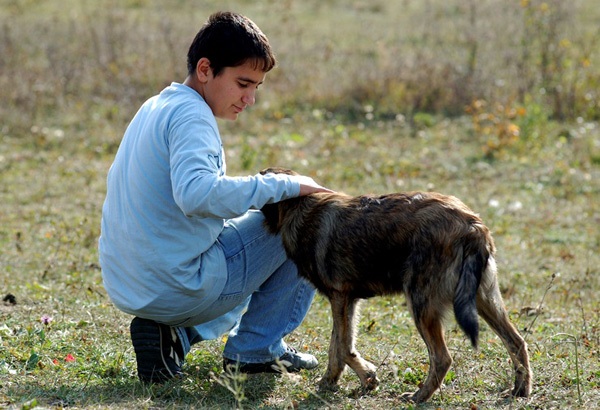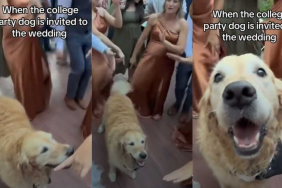by Michael Mountain
Founder, Best Friends Animal Society, Zoe, and The Stubby Dog Project
“It was like, uhh, he’s like me.”
I was sitting at a table with a group of teenagers in a rehab program – most of them from dysfunctional families. I was president at Best Friends Animal Sanctuary at the time, and we used to bring groups of young people to the sanctuary for week-long visits.
This was the group’s third day, and for the first two days they’d said almost nothing. Their eyes were glazed, they were unresponsive, and the most you’d hear from them was the occasional “this place sucks” or “stupid animals.”
But today something had begun to change, as always happened on these visits. This time, it was Sam who’d made “first contact.”
“I saw this dog,” he said, referring to Malcolm, a shepherd mix who, like Sam, had come to the sanctuary from an abusive situation. “He was, like, at the back, near the fence. He’s not like the other dogs. He’s like me.”
To be “like me” meant to not trust anyone and to be always on the defensive and emotionally shut down. Sam had noticed Malcolm eying him warily from the back of his play area, and now he wanted to get to know the dog better.
Other boys in the group would soon follow Sam’s lead, letting down their guard, too, spending more time with the dogs, taking them for walks, helping with feeding and poop-scooping. And that evening, back at their camp, the kids would compare notes. That would mean talking to each other.
By Day 5, they were having conversations around their campfire about their own lives, what it was like at home, how they’d gotten into trouble – things they’d never shared before. And by the last night of the visit, they were talking about the future, about life and death and their beliefs and ideas.
Sam and the other young people at the program in Utah were not, in fact, very different from a lot of kids today. Yes, they’d been dealt an extra tough hand in life and were perhaps more emotionally walled in. But none of them were out of reach of the animals and the natural world they were now discovering.
Like millions of other young people today, this group had spent little time outdoors, save for on the streets of their cities or towns. And although this week was a new experience, it touched something deep and meaningful within them. For the first time in their lives, as they began to make connections with the animals, the earth, and each other, they weren’t just making a new connection with the outside world of nature, but with their own inner nature, too.
Nature-Deficit Disorder
The phrase “nature-deficit disorder” was coined by Richard Louv, journalist and author ofLast Child in the Woods – Saving Our Children from Nature-Deficit Disorder.
“For tens of thousands of years,” Louv said, “children went outside and played in nature when they were growing up. And that is disappearing within a matter of a few decades in Western culture. We’re talking about a major change in human experience that has enormous psychological, physical and spiritual implications. We have to confront the fact that we’ve taken nature away from this and future generations and we need to make sure they get it back.”
An ever-growing number of health professionals are recognizing nature-deficit disorder as a critical factor in what ails young people (and older people, too), not just emotionally and psychologically, but also physically.
As technology has advanced, our connection to nature has retreated. Roughly 70 percent of all children and adolescents in the United States – more than 58 million – spend so little time in sunlight that they’re suffering from Vitamin D deficiency and a host of related illnesses that we thought we’d dealt with decades ago.
And while we’re now a wired generation, tethered to TVs, computers, video games and cell phones, we’ve lost touch with a lot that was once hard-wired in us all. A third of all young people, ages 2 to 19, are considered overweight or obese. That can lead directly to type-2 diabetes, asthma, hypertension and cardiovascular disease, just the beginnings of a lifetime of health problems as well as the associated costs to the health care industry.
The growing epidemic of attention deficit/hyperactivity disorder (ADD and ADHD) now affects nearly one in 10 children aged 4 to 17. Children with this condition are routinely treated with drugs like Ritalin. But a series of studies at the University of Illinois showed that when children with symptoms of ADD had even just a brief exposure to nature, their symptoms improved dramatically. One study noted that children with ADHD who took a 20-minute walk in natural surroundings — like a city park as opposed to city streets – showed better concentration in tests afterward than those who did not. They concluded that nature therapy be added to the drug and other treatments.
“I agree with them,” Louv said. “But I turn that around and I say: Could it be that at least part of the huge increase in the number of kids who are placed on Ritalin, etc., might have something to do with the fact we took nature away from them in the first place? It should be no surprise that kids become hyper-active when 40 percent of the school districts in the United States have either cut or eliminated recess.”
We’re part of nature
Most of us are already familiar with the benefits of pet therapy – how contact with other animals speeds recovery from sickness, especially for those in hospitals and nursing homes. It’s even been shown that people who have had surgery and who can just see some trees and grass out of the window tend to recover faster than those who can’t.
If nature can work wonders for us, then we can work wonders for nature, too. It’s a reciprocal relationship. Right now, the world of nature needs our help. Every day brings ever more dire predictions about climate change, greenhouse gases, the melting of the poles and the poisoning of the oceans. Governments remain largely paralyzed. International conferences bring few results. And for most of us, phrases like “CO2 emissions” and “carbon offsets” simply make our eyes glaze over.
Given our growing disconnect, that’s not surprising. How can we be passionate about protecting a world that we’ve never experienced? How can we feel motivated to save streams and woods when we’ve never walked among them? How can we desire to stop pollution when we’ve never tasted a deep breath of fresh air?
It’s one thing to know a lot of facts about the Amazon rainforest; it’s quite another to spend time among real trees. Fortunately, we don’t have to head to a distant forest to spend time among trees. They’re all around us, in parks, in the suburbs and on city streets. And knowing that they’re good for our health and that they reduce stress and crime in neighborhoods, many cities and towns have local groups that keep an eye on the health of their trees.
It naturally follows that people who grow up with a relationship to the trees in their own neighborhood are also much more likely to want to protect forests further away.
The more connected we feel to the animals, the oceans, the forests, and to the planet as our home, the more invested we become in doing what’s needed to relieve the stresses we’ve been putting on it. For thousands of years, we were inextricably tied to nature. We picked our food from trees; we hunted animals and thanked them when we took their lives; our rites of passage involved going into the wild and having a sacred experience with nature.
Sure, we’re not hunter-gatherers any more, and most of us wouldn’t want to be. In 2008, for the first time ever, more than half the people in the world were living in cities. Advances in technology are taking place at an exponential rate. There’s talk of a “post-human” or “trans-human” era arriving in 30 to 40 years. But there’s equally talk of how we’re approaching a tipping point where our disrespect toward nature will have caused irreversible damage to the planet.
The call of the wild, so to speak
The challenge, of course, is how in this increasingly urbanized world can young people even experience nature, let alone grow up with the knowledge and motivation they’re going to need in order to stem the tide of destruction currently being wreaked on the planet?
A growing number of organizations and networks are springing up all across the country to address that very need.
On Earth Day, 2009, Congressman John Sarbanes and Senator Jack Reed introduced the No Child Left Inside Act, urging Congress to include environmental education in the No Child Left Behind law. No Child Left Inside is a growing national coalition that already includes nearly 2,000 member groups in all 50 states.
Helping to drive campaigns like No Child Left Inside are networks of parents and teachers, the largest of which is the Children and Nature Network (C&NN).
“People often think nature is far away,” said Cheryl Charles, President and co-founder of the Children and Nature Network, “But it isn’t; nature is all around us.”
The C&NN website has numerous tips and ideas for giving young people the keys to the world of nature around them, including this excellent toolkit. Major government agencies and medical groups are advocates of No Child Left Inside. The Centers for Disease Control promotes nature-based activities for young people, and provides a toolkitabout the important role that schools and families can play. And the American Academy of Pediatrics is actively encouraging doctors to advise parents to get their children outside more.
The ideas and approaches being taken by these groups are easy and intuitive. That’s because their solutions are completely natural – they’re part of our basic makeup.
For starters, they advocate letting young people explore nature for themselves. Teaching kids about it is helpful; but letting them discover it for themselves is more helpful. It’s a world of wonder that sparks imagination, piques curiosity and unleashes creativity.
After all, the young people who came to spend a week at an animal sanctuary didn’t spend their time at classes, lectures or counseling. It was all about being with the animals, in the fresh air of red-rock canyon country.
And for a teenager named Sam, it was about meeting a curious black-haired shepherd mix who held a mirror up to him and showed him his own soul.
This article first appeared here on zoenature.org.
Michael Mountain is one of the founders of Best Friends Animal Society, the nation’s largest animal sanctuary and one of the pioneers of the no-kill movement for homeless pets. As president of Best Friends and editor of Best Friends magazine, he helped to build grassroots adoption and spay/neuter programs all over the country before stepping down in 2008. He currently is the editor and co-founder of Zoe— a new online magazine for people who care about animals, nature and the environment — and the co-founder of StubbyDog, which is working to change public perceptions of Pit Bulls.









